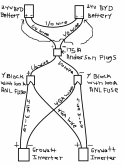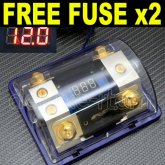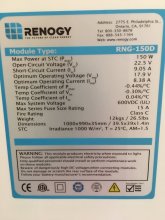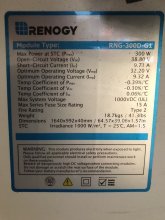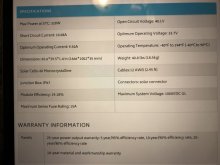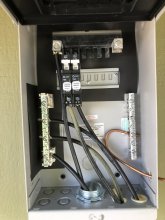Ok I am fixing to start installing my parts and pieces I have been collecting over the past 6 months for my off grid solar system for my shop. I have 24 Hyundai 260 watt solar panels (6.24 kw) specs are 260W, Voc 37.9v Isc 8.9a I will be installing them in a 3s-4p 12 panel setup x 2 separate arrays for 2 separate Growatt Inverters - 3120 watts 113.7 Volts and 35.6 amps per array. The 2 Inverters are Growatt SPF 3000 TL LVM 120V split phase 48V off grid inverters. The specs on them are Max PV array 4500W, battery voltage 48v dc, MPPT range 60Vdc to 115Vdc max pv open circuit voltage 145 vdc, max solar charge current 80A and AC charge current is 40A these specs are for each inverter. I will be connecting them together to make split phase 240vac. The Battery bank that I am going to start off with is 2 of the 24v BYD lithium batteries that I purchased from Tech Direct. specs on the batteries are Rated voltage 25.6V, Rated capacity 220Ah Energy 5.632Wh Maximum charge current 130A Maximum discharge current 350A Cell over discharge 2.5V Cell over charge 3.65V 70-80% + capacity
Battery chemistry - lithium iron phosphate (lifepo4) Maximum discharging pick is 500 amp BMS Included. I purchased the cable from tech direct to connect the batteries in series to make the 48v with the 175a anderson connectors when they arrived I noticed the wire for the cable is only a 6 awg wire I have ordered 3 more anderson 175a connectors for 1/0 wire I will be building my on cable for the batteries with 1/0 wire and the 3 new anderson connectors will the 1/0 wire be good enough from the batteries to a 1/0 in to 2- 4 gauge out y block with a 100a anl fuse then leave the y block with 2- 4 gauge positive wires to each inverter and the negative y block the same as the positive to each inverter negative . I am also installing a midnight solar 6 pv combiner box with 20 amp breakers at each array before it heads inside to the inverters. Can you guys look over my set up and let me know if my battery wire is going to be good enough and will the fuses and breakers I have listed work without any problems. I know I need to add a disconnect or breaker between my batteries and my inverters what do you suggest and do I need a breaker inside before my dc voltage connects to my inverters. if so what do you recommend. I am totally lost when it comes to proper wiring and breakers and fuses. Any help you guys can share with me will be greatly appreciated Thanks
Battery chemistry - lithium iron phosphate (lifepo4) Maximum discharging pick is 500 amp BMS Included. I purchased the cable from tech direct to connect the batteries in series to make the 48v with the 175a anderson connectors when they arrived I noticed the wire for the cable is only a 6 awg wire I have ordered 3 more anderson 175a connectors for 1/0 wire I will be building my on cable for the batteries with 1/0 wire and the 3 new anderson connectors will the 1/0 wire be good enough from the batteries to a 1/0 in to 2- 4 gauge out y block with a 100a anl fuse then leave the y block with 2- 4 gauge positive wires to each inverter and the negative y block the same as the positive to each inverter negative . I am also installing a midnight solar 6 pv combiner box with 20 amp breakers at each array before it heads inside to the inverters. Can you guys look over my set up and let me know if my battery wire is going to be good enough and will the fuses and breakers I have listed work without any problems. I know I need to add a disconnect or breaker between my batteries and my inverters what do you suggest and do I need a breaker inside before my dc voltage connects to my inverters. if so what do you recommend. I am totally lost when it comes to proper wiring and breakers and fuses. Any help you guys can share with me will be greatly appreciated Thanks



